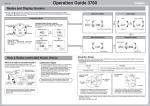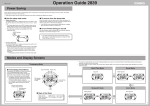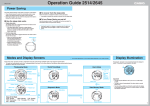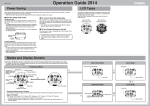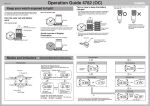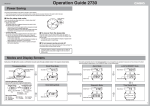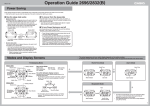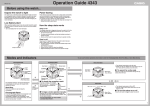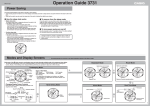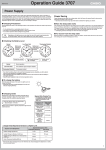Download Casio 3356 Watch User Manual
Transcript
Operation Guide 3311/3356 MA0406-EA Modes and Display Screens Each press of the C button sounds a confirmation tone and cycles through available modes in the sequence shown below. • The display will automatically revert to the Timekeeping screen if you leave the Battery Level, Alarm, or Hand Setting screen displayed without performing any operation for about two or three minutes. Battery Level Screen Timekeeping Mode World Time Mode ❚ Changing Display Screen Contents Each press of the shown below. Hour Hand City Code button cycles digital display contents in the sequence Day of the Week Day 2-second interval Or Calendar Screen Minute Hand Alarm Mode Alarm Number Day of the Week (Light) Or Button Button • For more information, see “To configure digital settings”. Button Button Current Time Screen Seconds Screen Hand Setting Mode Second Hand Stopwatch Mode Mode Indicator Hour Digital Display Minutes PM indicator (no indicator for AM) Mode Indicator Seconds Receive Icon (Indicates time calibration signal reception was successful.) Days of the Week SU: Sunday TH: Thursday MO: Monday FR: Friday TU: Tuesday SA: Saturday WE: Wednesday Power Supply The power supply of this watch uses a solar cell to generate electrical power, which is stored by a rechargeable battery. Using or storing the watch where it is not regularly exposed to light, or allowing it to be blocked from light by your sleeve for long periods as you are wearing it can cause the power of the rechargeable battery to run down. To ensure stable operation, be sure to allow the watch to be exposed to light as much as possible when you are wearing or storing it. Level 1 Level 2 Normal operation enabled. Level 3 Signal reception, tones (alarms, hourly time signal), display illumination, digital display, and analog timekeeping disabled. Important! Note that all data in memory and all settings are cleared whenever you allow the level of the rechargeable battery to drop to Level 4. Normal operation enabled. ❚ Checking the Battery Level Use the Battery Level Screen to check the current level of the watch’s rechargeable battery. • In the Timekeeping Mode, press the C button once to change to the Battery Level Screen. Timekeeping Mode Battery Level Screen Or Example: Day of the Week Level 4 All functions, including timekeeping, disabled. • Exposing the watch to direct sunlight or other strong light may cause the battery level indicator to momentarily indicate a level that is higher than the actual battery level. Because of this, you should wait for a short while after charging to check the battery level indicator. • Alarms and the hourly time signal cannot be turned on, and signal reception is disabled while the battery is at Level 3. • Signal reception will become enabled again when the battery is recharged up to Level 2. • Even after the battery drops to Level 4, watch operation will resume as soon as charging starts. However, you should wait until the digital display operation resumes before setting the time and date. ❚ Start charging at Level 3! ❚ Charging Precautions Battery Level 3 indicates that remaining battery power is very low. Be sure to expose the watch to light for recharging as soon as possible after the Level 3 indicator starts to flash. Avoid charging the watch in the following locations, and anywhere else where the watch may become very hot. • On the dashboard of an automobile parked in the sun • Very close to an incandescent light source or other sources of heat • In a location exposed to direct sunlight for long periods Note that the display panel may become black under very high temperatures. This is temporary, and the display will appear normal again at lower temperatures. ❚ Flashing Recover Indicator If you use the light or alarms a number of times during a short period, a recover (R) indicator flashes on the display and the following operations become disabled as battery power recovers. • • • • Display illumination Alarm and hourly time signal Analog timekeeping Time calibration signal reception Recover (R) Indicator Depending on the light source you are using, the case of the watch may become quite hot during charging. Take care to guard against burn injury after charging. Normal operation will return after the battery recovers. ❚ To charge the battery Point the solar panel (face) of the watch at a light source. • Remember that even a partial blockage of the solar cell reduces charging efficiency. Example: Positioning the watch Solar Cell • The illustration shows the resin band model. 1 Operation Guide 3311/3356 ❚ Charging Guide Required Daily Charging Time Starting from a full charge, the watch should be able to continue operating for about five months without further charging under the conditions described below. Daily Use (All time values are approximate.) • Display Illumination: 1.5 seconds • Alarms: 10 seconds • Signal reception: 5 times Making sure the watch is regularly exposed to light ensures stable operation. Power Saving • The following is the daily amount of charging required each day to support the operations under “Daily Use”. The Power Saving feature of the watch is turned on at the factory. • Power Saving causes the watch to automatically enter a sleep state and save power whenever the watch is left in the dark. • Note that the watch may also enter the sleep state if the watch is blocked from light by your sleeve. Exposure Level Approximate Exposure (Brightness) Time Outdoor Sunlight 5 minutes (50,000 lux) Sunlight Through a Window 24 minutes (10,000 lux) Daylight Through a Window on an Overcast 48 minutes Day (5,000 lux) Indoor Fluorescent 8 hours Lighting (500 lux) Approximate Exposure Time Level 4 \ Level 3 \ Level 2 \ Level 1 Outdoor Sunlight (50,000 lux) 1 hour 10 hours 5 hours Sunlight Through a Window (10,000 lux) 4 hours 48 hours 22 hours Daylight Through a Window on an Overcast Day (5,000 lux) 8 hours 99 hours 46 hours Indoor Fluorescent Lighting (500 lux) 76 hours ––– ––– ❚ To recover from the sleep state Display sleep state The display sleep state is triggered whenever the watch is left in the dark for three or four days. • The display sleep state causes the display to go blank, except for a flashing Power Saving indicator. Alarms and the hourly time signal continue to operate normally while the watch is in the display sleep state. Even when the watch is in the display sleep state, digitalanalog time coordination and auto signal receive are both performed. Move the watch to a brightly lit location or press any button. • It can take up to two seconds before display figures re-appear after you place the watch in a well-lit area. Function sleep state The function sleep state is triggered whenever the watch is left in the dark for four days. • Alarms and the hourly time signal are also disabled while the watch is in the function sleep state. In the function sleep state, analog timekeeping is disabled, and auto signal receive is not performed. • Digital timekeeping functions continue to operate normally in the function sleep state. • Charge Times Required to Advance to a Higher Level Exposure Level (Brightness) ❚ How the sleep state works ❚ To turn Power Saving on and off Use the procedure under “To configure digital settings” to turn Power Saving on or off. Leaving the watch in a drawer or anywhere else it is dark can cause Power Saving to trigger in order to conserve battery power. Power Saving Indicator • Note that the above charging times are for reference only. Actual charging time depends on a variety of environmental factors. 3. Display Illumination Pressing the B button in any mode illuminates the digital display for easy reading. ❚ To specify the illumination duration 1. In the Timekeeping Mode hold down the A button for about two seconds. Timekeeping Mode • This will display the transmitter selection mode setting screen and cause the second hand to move to the 12 o’clock position. Press the B button to select the display illumination duration you want. 1.5 seconds (Toggle) • Each press of the B button toggles the display illumination duration between 1.5 seconds and 2.5 seconds. An indicator on the display shows which setting is currently selected. 2.5 seconds You can specify 1.5 seconds or 2.5 seconds as the duration of display illumination. 4. AT (Auto Switching) 2. Press the A button once and then press the C button. • This causes the seconds count to flash on the display. When the setting is the way you want, press the A button. • This will exit the setting screen and return to the Timekeeping Mode screen. Also, the second hand will move automatically to the current second, as kept by digital timekeeping. • The display also will exit the setting screen automatically if you do not perform any operation for about two or three minutes. 2 Operation Guide 3311/3356 How a Radio-controlled Watch Works What is a radio-controlled watch? Calibration Signal Your radio-controlled watch is designed to receive a time calibration signal that contains standard time data, and adjust its current time setting accordingly. • The Japanese calibration signal (Call Sign: JJY) is maintained by the National Institute of Information and Communications Technology (NICT). It is a long wave signal transmitted 24 hours a day from the Mt. Otakadoya transmitter (40kHz) located in Tamura-gun, Fukushima Prefecture, and from the Mt. Hagane transmitter (60kHz) located on the border between Saga Prefecture and Fukuoka Prefecture. • The U.S. calibration signal (Call Sign: WWVB) is transmitted by the National Institute of Standards and technology from Fort Collins, Colorado. Transmitter Long-wave time calibration signal Signal is received using built-in antenna. Watch decodes received data and converts it to time data. Signal data Decode Cesium atomic clock Time data Watch Internally Note that transmission of the standard wave may be interrupted occasionally due to maintenance, lightening, etc. Time is adjusted according to time data. Reception Range This watch is designed to receive the standard time calibration signal of Japan (JJY) or of the United States (WWVB). The signal that is received depends on the current Home City setting. • For information about selecting a Home City, see “Selecting Your Home City”. For information about city codes, see the “World Time City Code List”. Home City Transmitter Either the Mt. Otakadoya signal (40kHz) or the Mt. Hagane signal (60kHz) TYO Fort Collins, Colorado signal LAX, DEN, CHI, NYC Japan Transmitter Locations 1000km U.S. Transmitter Location 3000km 500km 500km Mt. Hagane (60kHz) Mt. Otakadoya (40kHz) 1000km Fort Collins 1000km After the watch receives the Standard Time signal, it performs internal calculations to determine the current time. Because of this, there may be an error of up to one second in the displayed time. • Under optimum conditions, the calibration signal should be receivable up to 1,000 kilometers from the transmitter. Note that the wave is relatively weak at distances greater than 500km, so reception may be poor at long distances. • Under optimum conditions, the calibration signal should be receivable up to 3,000 kilometers from the transmitter. Note that the wave is relatively weak at distances greater than 1,000km, so reception may be poor at long distances. • Geographic contours, nearby buildings, seasonal conditions, the time of day, can even make reception impossible even when you are within range of the transmitter. • Best reception is possible late at night. Location Receiving the Calibration Signal ❚ Time Required for Reception ❚ Receive Icon Reception is difficult and may even be impossible in the locations described below. Avoid such locations when performing signal reception. • You should think of your watch operating like a radio or TV when it is receiving the calibration signal. There are two methods you can use to receive the time calibration signal. • Auto receive (Reception is performed automatically at midnight, 1:00, 2:00, 3:00 and 4:00 each morning.) • Manual receive (You initiate reception using a button operation.) • If reception is not successful for any of the normal auto receive operations shown above, auto receive is performed one more time at 5:00 a.m. • The watch is set up for auto receive at the factory, so all you need to do is to place it in a location that allows good reception each night. A calibration signal receive operation takes anywhere from about two to six minutes. • Note that when “AT” (Auto Select) is specified as the transmitter selection mode, signal reception can take up to 12 minutes. • See “Configuring Transmitter Selection Mode Settings” for more information. The receive icon cycles from “Unstable” through “Stable” as shown below while reception is in progress. How far it cycles depends on the signal strength. Keep the watch in a location where reception is stable while reception is in progress. Among or near buildings Near high-voltage lines ❚ To position the watch for optimum reception Remove the watch from your wrist and place it somewhere so its top (12 o’clock side, where the antenna is located) is facing approximately in the direction of the signal transmitter. Keep the watch away from metal objects. Inside a vehicle (automobile, train, plane, etc.) In a location where there is radio interference (construction site, airport, etc.) Next to a household appliance or office equipment (TV, speaker, fax, computer, cell phone, etc.) In the Timekeeping Mode, hold down the D button for about two seconds. • The watch will beep and reception will start. An indicator flashes on the display and the while receive icon changes to signal reception is in progress. Press the D button. Near mountains If you are experiencing problems with reception, move away from the types of locations described above to a location with better reception, and try again. ❚ To perform manual receive ❚ To interrupt reception Resin band Metal band • Orienting the watch so it is sideways to the transmitter makes it more difficult to receive the signal. • Do not move the watch while it is receiving the calibration signal. Receive Icon • All other buttons besides D are disabled during signal reception. When reception is successful The watch terminates reception and adjusts the current time. Next it beeps and then displays the date and time that the adjustment was performed. • At this time, the second hand will adjust automatically to the digital time. • After the date and time of the adjustment appear on the display, press the D button to return to the Timekeeping Mode. The watch will also return to the Timekeeping Mode automatically if you do not perform any operation for about one or two minutes. Reception Error (ERR Indicator) The watch does not adjust its current time setting, and displays “ERR” when signal reception is unsuccessful for some reason. • The watch will return to the Timekeeping Mode automatically if you do not perform any operation for about one or two minutes. Unstable Stable • Even under optimum reception conditions, it can take about 10 seconds for reception to stabilize. • Use the receive icon to check reception status and to determine the best location for signal reception. • Note that weather, the time of day, surroundings, and other factors can all affect reception. ❚ Analog Hands and Signal Reception Second Hand The second hand moves to the 12 o’clock position when signal reception starts. • It resumes normal movement after reception is complete. • Pressing a button to stop reception causes the second hand to move to the seconds count as kept by digital timekeeping, and resume normal operation. Hour and Minute Hands These hands continue to operate normally. Note that the second hand does not move while signal reception is in progress. 3 Operation Guide 3311/3356 ❚ To view the last reception date and time In the Timekeeping Mode, press the D button. • This causes the display to start cycling between the date, time, and receive icon screens at two-second intervals. • To return to the Timekeeping Mode, press the D button again. • The watch will return to the Timekeeping Mode automatically if you do not perform any operation for about one or two minutes. About two seconds About two seconds About two seconds Signal Reception Settings ❚ Selecting Your Home City • Home City Specify the city code of your “Home City”, which is the location where you will normally use the watch. • Summer Time (Daylight Saving Time) Use this setting to specify whether summer time (Daylight Saving Time) settings should be made automatically by the watch. • Auto Receive This setting is used to select either auto receive or manual receive. • Transmitter Selection Mode This setting is used to specify which transmitter’s signal should be used for time calibration in Japan. • Auto receive can be selected only when TYO, LAX, DEN, CHI, or NYC is currently selected as the Home City. The initial factory default configuration of signal reception settings are shown below. You do not need to change these settings if you use the watch in Japan. • Check the signal reception settings whenever you have problems with signal reception or when the time setting produced by signal reception is incorrect. Note that time calibration signal reception is performed only when one of the city codes shown below is selected as the Home City. • Select TYO (Tokyo) as your Home City if you plan to use the watch in Japan. Home City Summer Time TYO A Tokyo Home City ON On Transmitter AT Auto Japan transmitter select (40kHz/ 60kHz) Either the Mt. Otakadoya signal (40kHz) or the Mt. Hagane signal (60kHz) TYO Fort Collins, Colorado signal LAX, DEN, CHI, NYC 1. Timekeeping Mode In the Timekeeping Mode, hold down the A button for about two seconds. 2. • This will display the transmitter selection mode setting screen and cause the second hand to move to the 12 o’clock position. Auto switching in accordance with signal data Auto Receive Transmitter When the city code you want is displayed, press the A button twice. • This will exit the setting screen and return to the Timekeeping Mode screen. Also, the second hand will move automatically to the current second, as kept by digital timekeeping. • The display also will exit the setting screen automatically if you do not perform any operation for about two or three minutes. (Twice) ❚ Configuring Summer Time (Daylight Saving Time) Settings • When using this watch in Japan, it is recommended that you use the “A” (Auto) summer time setting. 1. In the Timekeeping Mode hold down the A button for about two seconds. Timekeeping Mode (Moves Flashing) (Changes Setting) 2. DST Indicator Press the C button twice to select the Summer Time setting. • This will cause the current DST setting to flash on the display. • The example screen shows the auto A setting. 3. (Scrolls Forward) • Turning on summer time (ON) causes the current time setting to advance one hour. OF (Changes Setting) ON This setting enables the auto summer time setting, which turns summer time on or off in accordance with the received time calibration signal. • This setting uses Japan summer time data when TYO is selected as the Home City, and U.S. summer time data when NYC, CHI, DEN, or LAX is selected as the Home City. • Note that “A” can be selected only when TYO, LAX, DEN, CHI, or NYC is selected as the Home City. Use the D (+) and B (–) buttons to scroll through the city codes until the one you want to select is displayed. (Forward) • Holding down either button scrolls at high speed. • See the “World Time City Code List” for information about city codes. 4. Press the D button to cycle through the summer time settings in the sequence shown below. • A (AUTO) (Displays/Exits Setting Screen) (Back) 3. A • This will display the transmitter selection mode setting screen and cause the second hand to move to the 12 o’clock position. • This causes the currently selected city code to flash on the screen. • Example shows Tokyo city code (TYO). (Displays/Exits Setting Screen) (Scrolls Back) (Moves Flashing) 4. Press the C button once to select the Home City setting. When the summer time setting is the way you want, press the A button twice. (Twice) • This will exit the setting screen and return to the Timekeeping Mode screen. Also, the second hand will move automatically to the current second, as kept by digital timekeeping. • The display also will exit the setting screen automatically if you do not perform any operation for about two or three minutes. Summer time, or Daylight Saving Time (DST) as it is known in some countries, calls for setting clocks ahead one hour during the summer season. Note that the use of summer time depends on the country and even the local area. • OF (OFF) This setting turns off summer time and returns to normal timekeeping. • ON (Twice) This setting turns on summer time and advances the current time by one hour. • The DST indicator appears on the display while summer time is turned on. 4 Operation Guide 3311/3356 ❚ Configuring Auto Receive Settings ❚ Configuring Transmitter Selection Mode Settings Auto receive settings can be configured only when TYO, LAX, DEN, CHI, or NYC is selected as the Home City. • When using this watch in Japan, it is recommended that you use the “ON” summer time setting. Note that the transmitter selection mode setting can be configured only when TYO is selected as the Home City. • When using this watch in Japan, it is recommended that you use the “AT” (Auto) transmitter selection mode setting. 1. 1. In the Timekeeping Mode hold down the A button for about two seconds. Timekeeping Mode • This will display the transmitter selection mode setting screen and cause the second hand to move to the 12 o’clock position. (Displays/Exits Setting Screen) 3. • Each press of the D button toggles auto receive on (ON) and off (OF). • “– –” is displayed for the auto receive setting when the current Home City setting is a code other than TYO, LAX, DEN, CHI, or NYC. 4. (Moves Flashing) (Changes Setting) 2. Press the C button three times to select the auto receive setting. • This will display “R/C”, along with the current auto receive (3 times) setting. • The example screen shows auto receive on (ON). • AT (AUTO) With this setting, the watch automatically selects either the Mt. Otakadoya signal (40kHz) or the Mt. Hagane signal (60kHz), whichever is strongest. • JP40 With this setting, the watch always receives the Nt. Otakadoya signal (40kHz). • JP60 With this setting, the watch always receives the Mt. Hagane signal (60kHz). • US60 With this setting, the watch receives the Fort Collins, Colorado signal. 3. When the setting you want is displayed, press the A button twice. • This will exit the setting screen and return to the Timekeeping Mode screen. Also, the second hand will move automatically to the current second, as kept by digital timekeeping. • The display also will exit the setting screen automatically if you do not perform any operation for about two or three minutes. (Twice) Press the D button to toggle auto receive on (ON) or off (OFF). When the auto receive setting is the way you want, press the A button twice. (Changes Setting) In the Timekeeping Mode hold down the A button for about two seconds. Timekeeping Mode • This will display the transmitter selection mode setting screen and cause the second hand to move to the 12 o’clock position. (Displays/Exits Setting Screen) 2. Use the D button to scroll through the transmitter selection mode settings until the one you want is displayed. • When TYO is selected as the Home City, each press of the D button cycles through available settings in the sequence shown below. AT (Twice) JP40 (Changes Setting) JP60 (Moves Flashing) (Changes Setting) • When LAX, DEN, CHI, or NYC is selected as the Home City, “US60” is displayed for the transmitter selection mode setting. This setting is fixed, and cannot be changed. • When the current Home City setting is a code other than TYO, LAX, DEN, CHI, or NYC, “– –” is displayed for the auto receive setting. This indicates that the setting cannot be changed. • This will exit the setting screen and return to the Timekeeping Mode screen. Also, the second hand will move automatically to the current second, as kept by digital timekeeping. • The display also will exit the setting screen automatically if you do not perform any operation for about two or three minutes. US60 Calibration Signal Reception Precautions • Auto reception can be performed while the watch is in the Timekeeping Mode or World Time Mode only. • Signal reception is cancelled if an alarm starts to sound while it is being performed. • Pressing any button while auto reception is in progress will cause the watch to beep and then exit the receive operation. • The watch’s calendar shows dates up to the year 2099. Attempting a receive operation after that causes an error. • Make sure you are within the range of the calibration signal transmitter before performing the reception operation. Remember that geographic contours, nearby buildings, seasonal conditions, the time of day, can even make reception impossible even when you are within range of the transmitter. • Proper reception may be impossible if there is something blocking the signal. If reception is unsuccessful, try again. • This watch is designed to adjust its current time setting in accordance with the calibration signal transmitted in Japan and the United States only. Note that you will need to make your own adjustments when using this watch outside of Japan or the United States, or in any area that is outside the range of the receivable time calibration signal transmitters. • When the watch is unable to adjust its time signal using the calibration signal for some reason, timekeeping accuracy is within ±15 seconds per month. • Strong electrostatic charge can cause timekeeping error. 5 Operation Guide 3311/3356 Auto receive is turned on (ON), but the receive icon “ ” is not on the display. Troubleshooting The watch cannot receive the time calibration signal. • Is the signal being transmitted? Though the Japanese calibration signal (Call Sign: JJY) is continually transmitted by the National Institute of Information and Communications Technology (NICT) in theory, it may sometimes be interrupted for periodic maintenance work, or because of lightening or other problems. • Are you within the reception range of a transmitter? See “Reception Range” for information about areas where the watch can receive the signal. • Is there something in the immediate area that may be interfering with reception? Even if you are within the reception range of a transmitter, objects between you and the transmitter or electrical noise can interfere with reception. Avoid such areas during signal reception. See “Location” for more information. • Do you have the correct Home City code selected? Remember that auto receive is not performed unless TYO (Japan), NYC (New York), CHI (Chicago), DEN (Denver), or LAX (Los Angeles) is selected as the Home City. Select the correct Home City code using the procedure under “Selecting Your Home City”. • Is auto receive turned off (OF)? Use the procedure under “Configuring Auto Receive Settings” to turn on auto receive. • Is the watch in any mode other than the Timekeeping Mode or World Time Mode during the auto receive times (midnight, 1:00 a.m., 2:00 a.m., 3:00 a.m., 4:00 a.m., and 5:00 a.m.)? Auto receive is performed only when the watch is in the Timekeeping Mode or World Time Mode. It is not performed if the watch is in any other mode. Time calibration signal reception is successful, but the hourly time signal and current time are slightly off. • After the watch receives the time calibration signal, it performs an internal decoding process before updating its time setting. Because of this, the time setting may be slightly off (within one second). Time calibration signal reception is successful, but the current time is one hour fast. • Do you have summer time (DST) turned on (ON)? Use the procedure under “Configuring Summer Time (Daylight Saving Time) Settings” to turn off summer time. Time calibration signal reception is successful, but the current time setting is wrong. • Is the correct city code selected for your Home City? If you are in Japan, you should have TYO selected for your Home City. For other areas, select the correct Home City code using the procedure under “Selecting Your Home City”. Timekeeping Mode The current auto receive on (ON)/off (OF) setting does not appear on the setting screen. • The auto receive on (ON)/off (OF) setting is not displayed unless TYO (Japan), NYC (New York), CHI (Chicago), DEN (Denver), or LAX (Los Angeles) is selected as the Home City. Use the procedure under “Selecting Your Home City” to select your correct Home City. The AT, JP40, and JP60 options do not appear for the transmitter selection mode setting. Summer time, or Daylight Saving Time (DST) as is it is known in some countries, calls for setting clocks ahead one hour during the summer season. Note that the use of summer time depends on the country and even the local area. ❚ To search for a city code In the World Time Mode, press the D button. • This scrolls westward through the available city codes. A short while after a city code appears, the display will change to show the current time in that city. • Holding down the D button scrolls at high speed. ❚ To turn summer time on or off 1. World Time Mode City Code (Changes Display) (Twice) 2. About two seconds Example: Day of the Week (Scrolls Forward) Current Time in Selected City Important! If the World Time Mode time is incorrect, correct the setting of the current time in the Timekeeping Mode. • For information about selecting a Home City, see “Selecting Your Home City”. • Pressing the A button in the World Time Mode displays the city code of the currently selected city for about two seconds. • Auto receive is performed in the middle of the night, when reception conditions are best. Before going to bed at night, place the watch near a window, with its 12 o’clock position facing in the general direction of the transmitter. How can I perform manual receive? • Hold down the lower right D button for about two seconds. The watch will beep to indicate that manual receive has started. Place it near a window, with its 12 o’clock position facing in the general direction of the transmitter. How can I view the last reception date and time? • In the Timekeeping Mode, press the lower right D button. This will display the date and time that the time calibration signal was last received successfully. To return to the Timekeeping Mode, press the D button again. See “To view the last reception date and time” for more information. • The AT, JP40, and JP60 transmitter selection mode options are available only when TYO (Tokyo) is selected as the Home City code. Use the procedure under “Selecting Your Home City” to select your correct Home City. Using Summer Time (DST) World Time Mode World time lets you display the current time in any one of 30 cities (29 time zones) around the world. • When you enter the World Time Mode, the screen for the city that was displayed when you last exited the mode appears first. • The seconds count in the World Time Mode is linked with the Timekeeping Mode seconds count. • The same 12-hour/24-hour format you select for the Timekeeping Mode time is also applied in the World Time Mode. • The receive icon appears when a signal is received successfully and the time is updated. It is not displayed if there is no successful signal reception throughout the day. Also note that the icon disappears from the display each day at 3:00 a.m. Make sure that you are using the watch in an area that is within the reception range of a transmitter, and make sure that the watch is in the Timekeeping Mode or World Time Mode when it is time for auto signal reception. What time is auto receive performed? In the World Time Mode, use the D button to display the screen for the city code whose summer time setting you want to change. Hold down the A button for about two seconds. • This toggles summer time on and off. • The “DST” indicator appears on the display and timekeeping is advanced by one hour when summer time is turned on. • You can turn summer time on or off independently for each World Time Mode city. Note, however, that you cannot turn on summer time for the “GMT” city code. DST Indicator (Changes Setting) (Scrolls City Codes) World Time City Code List City GMT Code Differential City Name City GMT Code Differential City Name Jerusalem ––– –11 JRS +2 HNL –10 Honolulu JED +3 Jeddah ANC –9 Anchorage THR +3.5 Teheran Dubai LAX –8 Los Angeles DXB +4 DEN –7 Denver KBL +4.5 Kabul CHI –6 Chicago KHI +5 Karachi NYC –5 New York DEL +5.5 Delhi CCS –4 Caracas DAC +6 Dakar RIO –3 Rio de Janeiro RGN +6.5 Yangon ––– –2 BKK +7 Bangkok Hong Kong ––– –1 HKG +8 GMT +0 Greenwich Mean Time SEL +9 Seoul LON +0 TYO +9 Tokyo Adelaide London PAR +1 Paris ADL +9.5 BER +1 Berlin SYD +10 Sydney ATH +2 Athens NOU +11 Noumea CAI +2 Cairo WLG +12 Wellington • The contents of the above table are current as of December 2003. • Time differentials in the above table are in accordance with Universal Time Coordinated (UTC). 6 Operation Guide 3311/3356 ❚ To set an alarm time Using the Alarms and Hourly Time Signal 3. Example: To set Alarm 2 for 3:30 p.m. You can set the daily alarms in 1-minute increments. The watch beeps for 10 seconds when the current time in the Timekeeping Mode reaches the alarm time you set. There are three independent alarms, and all of them operate the same way. The Hourly Time signal causes the watch to beep every hour on the hour. ❚ To select an alarm or the Hourly Time Signal screen Each press of the D button cycles through available screens in the sequence shown below. Alarm 1 Alarm 2 When you enter the Alarm Mode, the screen for the alarm that was displayed when you last exited the mode appears first. Timekeeping Mode 1. (Selects Alarm) • An alarm number (AL1, AL2, AL3) indicates the current screen. Alarm Number 2. Hourly Time Signal (3 times) In the Alarm Mode, use the D button to scroll through the alarm screens until the one whose setting you want to change is displayed. Hold down the A button for about two seconds. (Setting Screen) Alarm 3 • This will cause the hour digits of the displayed alarm time to flash. • Displaying the setting screen automatically turns on the displayed alarm. 2-second interval (Back) Use the D (+) and B (–) buttons to change the hour setting. • In this example, set the hour digit to 3 p.m. • Holding down either button changes the setting at high speed. • When setting the hour, make sure you specify AM (no indicator) or PM (P) correctly when using 12-hour timekeeping, or that you specify the correct 24-hour time. • The same 12-hour/24-hour format you select for the Timekeeping Mode time is also applied in the Alarm Mode. 4. (Forward) Minutes Press the C button to select the minute setting. • This causes the minute digits to flash. Alarm Time (Selects Setting) Hour 5. Use the D (+) and B (–) buttons to change the minute setting. • Holding down either button changes the setting at high speed. (Back) ❚ To turn an alarm or the hourly time signal on or off 1. In the Alarm Mode, use the D button to display the screen for the setting you want to turn on or off. The stopwatch measures elapsed time in units of 1/100 second up to 99 minutes, 59.99 seconds (100 minutes total). When the maximum limit is reached, the elapsed time automatically returns to zero and timing continues from there. (Forward) Timekeeping Mode • Each press of the D button advances to the next alarm, which is indicated by the alarm number on the display. 2. 6. When the setting is the way you want, press the A button. Alarm Mode Indicator (Selects Alarm) Press the A button to toggle the currently displayed alarm on or off. (On/Off) Stopwatch Mode Alarm Number (4 times) About two seconds ❚ Display Screen Switching • Elapsed Time Screen A 1/100 second value is displayed for the first minute after you start an elapsed time measurement. After the first minute, the screen changes automatically to show elapsed minutes and seconds. Minute and Second Screen Minutes Seconds Hourly Time Signal (On/Off) • This exits the setting screen. • The display also will exit the setting screen automatically if you do not perform any operation for about two or three minutes. ❚ To stop the alarm beeper Press any button. ❚ To test the alarm In the Alarm Mode, hold down the D button to sound the alarm. A Button Split/Reset • Press during elapsed time measurement to display the split time. • Press when elapsed time measurement is stopped to reset the stopwatch to all zeros. Seconds 1/100 Second • Paused Elapsed Time Measurement Screen When elapsed time measurement is paused, the display alternates between a minute/second screen and a 1/100 second screen at 1-second intervals. Minutes D Button Start/Stop • Each press starts and stops elapsed time measurement. Second 1/100 Second 7 Operation Guide 3311/3356 ❚ Elapsed Time Measurement Configuring Time and Date Settings Manually Start Stop Reset Pressing the A button while timing is stopped resets the stopwatch to all zeros. Cumulative Time Measurement Pressing the D button to restart the stopwatch without resetting it to all zeros causes the elapsed time measurement to resume from where it was last stopped. If you are planning to manually adjust both the digital and analog settings, be sure to adjust the digital setting first. Time and Date Settings ❚ Split Time Measurement • Displays Setting Screen • Changes Setting Group • Exits Setting Screen Timekeeping Mode Start Record Split Clear Split Stop Pressing the A button while timing is being performed displays the split time screen, but timing continues internally. • Changing to another mode while a split time is displayed clears the split time operation. Reset (Hold down about two seconds.) ❚ 1st and 2nd Place Finishers Start 1st Finish 2nd finish Displays time of 2nd finisher. Reset (Displays time of 1st finisher.) Pressing the D button while the split time screen is on the display stops elapsed time measurement, and leaves the split time screen on the display. Press the A button to exit the split time screen and display the elapsed time when the measurement was stopped. Transmitter Selection Mode Home City Code Auto Receive Summer Time 12/24-hour timekeeping Split Time Screen Minutes Split Indicator Seconds (Selects Setting) You can select either Japanese (kanji) or English for the day of the week indicator. • For more information, see “To configure digital settings”. Day of the Week Indicators Seconds Hour Minute Year 1/100 Second The split time screen cycles alternately cycle through the split indicator, a minute/second screen, and a 1/100 second screen. Power Saving Language Day Month • While the setting screen (the one with a flashing setting) is on the display, use the C and A buttons to move the flashing between settings. ❚ To configure digital settings 1. 3. Timekeeping Mode In the Timekeeping Mode hold down the A button for about two seconds. 5. Press the C button so the setting you want to change is flashing on the display. • Use the C button to cycle (Selects Setting) through the settings shown below. Each press of the C button causes the next setting to flash. • This will display the transmitter selection mode setting screen and cause the second hand to move to the 12 o’clock position. (Enters/Exits Setting Screen) (Scrolls Back) 12/24-hour Timekeeping Power Saving Second Hour Language Minute Day Year 2. Press the A button to advance to the next group of settings. • This causes the 12/24-hour timekeeping setting to flash. Example: 12H (12-hour timekeeping) • While the seconds are selected, press the D button (Zero Reset) to reset them to 00 in accordance with the time signal on the radio, TV, etc. • Pressing the D button while the seconds count is in the range of 30 to 59 resets it to 00 and also adds 1 to the minutes. Pressing the D button in the range of 00 to 29 resets the seconds count without changing the minutes. • Pressing the B button while the seconds count is flashing changes the display illumination duration. See “To specify display illumination duration” for more information. 6. 4. While the 12/24-hour timekeeping setting is flashing, press the D button to select the setting you want. • Pressing the D button toggles the timekeeping format between 12-hour (12H) and 24-hour (24H). Tuesday: TU/ 火 Friday: FR/ 金 See “Signal Reception Settings” for information about calibration signal, Home City, summer time, and auto receive settings. 7. To restart the seconds count to 00, press the D button. Monday: MO/ 月 Thursday: TH/ 木 While the day of the week setting is flashing, press the D button to toggle it between Japanese (kanji) and English. Japanese (Kanji) (Toggles) 8. While the Power Saving setting is flashing, press the D button to toggle it on (ON) or off (OF). (Toggles) Month (Changes Selection) (Scrolls Forward) (Changes Setting Group) Sunday: SU/ 日 Wednesday: WE/ 水 Saturday: SA/ 土 (Toggles) While the hour, minutes, year, month, or day setting is flashing, use the D (+) and B (–) buttons to change the setting. (Back) • Holding down either button (Forward) changes the setting at high speed. • When setting the hour, make sure you specify AM (no indicator) or PM (P) correctly, or that you specify the correct 24-hour time. • You can set a date in the range of January 1, 2000 to December 31, 2099. • The day of the week is set automatically in accordance with the date you set. • The watch automatically makes adjustments for leap years and month lengths. Use the C button to select each of the settings and the D and B buttons to change them. 9. When all of the settings are the way you want, press the A button. • This exits the setting screen. • The display also will exit the setting screen automatically if you do not perform any operation for about two or three minutes. 8 Operation Guide 3311/3356 Digital-Analog Synchronization After adjustment of the digital time, the watch automatically adjusts its analog setting to match. • When adjusting the analog time, the hands may move clockwise or counterclockwise. • Depending on how many hours different the digital and analog time settings are, it may take some time for the analog hand setting procedure to be finished. • After adjustment of the hour and minute hand, the second hand will adjust automatically to the digital time. Ajusting the Analog Time Setting 2. You can use the Hand Setting Mode to manually adjust the analog time when it does not match the digital time. Timekeeping Mode Hand Setting Mode • Each press of the D button advances the second hand one second. • Holding down the D button advances the second hand at high speed. 3. High-speed Lock If the second hand does not align properly with the 12 o’clock position, press the D button to adjust it. (Forward) 5. Press the C button. (5 times) • This will cause the hour and minute setting of the digital time to flash on the display. Mode Indicator 1. In the Hand Setting Mode, hold down the A button for about two seconds. • This will cause the second hand to move to 12 o’clock, and “–00–” to flash on the digital display. Hand Setting Mode (Selects Setting) 4. Use the D (+) and B (–) buttons to adjust the hour and minute hands. • Each press of the D button moves the hands 20 seconds clockwise, while the B button moves them 20 seconds counterclockwise. • Holding down either button moves the hands at high speed. • While holding down the D button to start high-speed clockwise movement of the hands, press the B button to lock the high-speed hand movement. You can then release the buttons. • While holding down the B button to start high-speed counterclockwise movement of the hands, press the D button to lock the high-speed movement. You can then release the buttons. • High-speed hand movement will continue until it completes a 12-hour cycle, or until you press any button to stop it. (Back) When the setting is the way you want, press the A button. • This exits the setting screen and automatically synchronizes the minute hand with the current seconds count. • At this time, the second hand will adjust automatically to the digital time. • The display also will exit the setting screen automatically if you do not perform any operation for about two or three minutes. (Forward) 9









